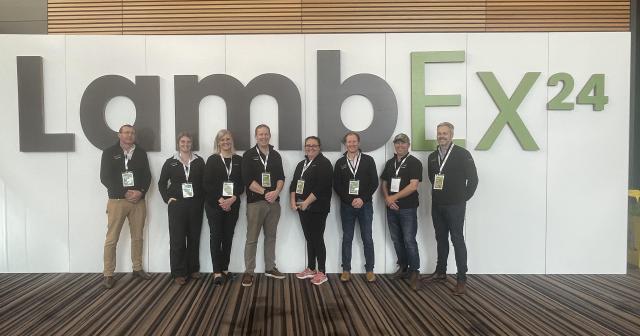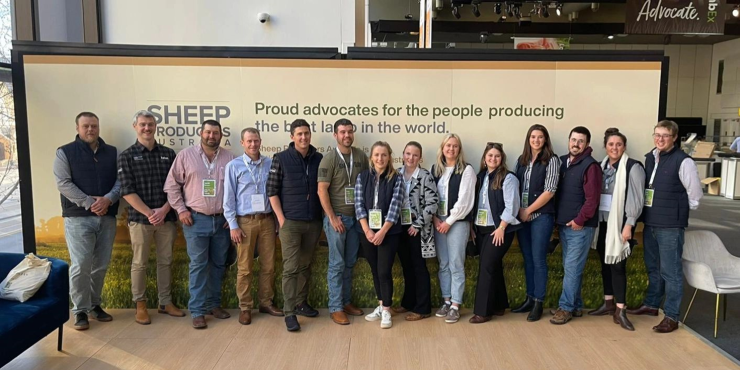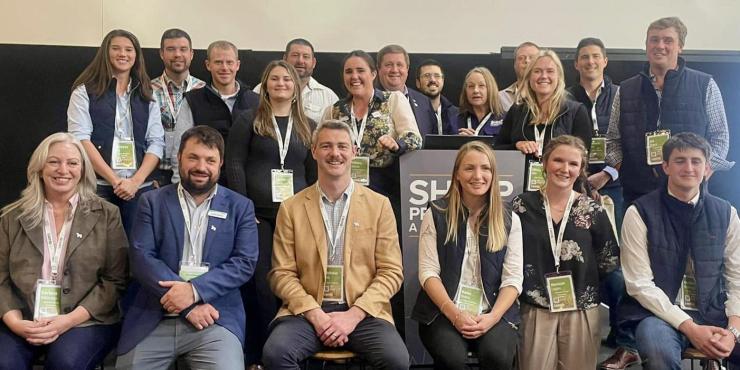Representatives from Beef + Lamb New Zealand (B+LNZ) recently joined over 1,500 global attendees at the LambEx Conference in Adelaide, Australia. This conference, held from 7-9 August, brought together the world’s leading sheep, lamb, and wool industry experts to share the latest innovations, research, and industry trends.

In addition to the conference, B+LNZ maximised the value of the trip by scheduling meetings with international counterparts and farm visits.
Five B+LNZ Farmer Councillors and one Kāhui member (a Māori Agribusiness stakeholder) attended the conference. B+LNZ also funded two young New Zealand farmers, Hamish Best and Olivia Ellis, to attend alongside young farmer representatives from Australia, Canada, USA and the UK as part of the Global Sheep Forum’s Next Generation Programme.
Justine Kidd, B+LNZ’s GM Extension, attended and notes that the packed agenda, both before and during the conference, allowed B+LNZ to build valuable connections and gain insights into the Australian and global sheep industry.
She says, “The tour kicked off with a highly informative day visiting Ashmore Rams, connecting with the New Zealand Merino producer tour, and meeting researchers from Adelaide University over dinner, where Dr. Jason Trompf presented his research on ewe wastage and lamb survivability.
“We then immersed ourselves in the LambEx 24 programme, attending technical talks, engaging with trade exhibitors and exploring the extensive conference content. We wrapped up with a debrief over breakfast on Saturday morning before heading home—exhausted, inspired, and full of new insights!
“One benefit of attending LambEx 24 was strengthening connections with our international counterparts. The Australian researchers and producer groups were very open and interested in the opportunities for collaboration across the Tasman, connecting to tackle shared challenges and explore opportunities for mutual benefit,” she says.
Kidd says a key takeaway for their group was the Australian lamb supply chain's clear focus and alignment. “Two messages resonated throughout our conversations: the importance of the eating experience and the need to improve efficiency. From ram breeders to researchers and processors, everyone was committed to these goals.
“This unified approach appeared to have Australian lamb production moving forward at pace, the challenges were acknowledged, and the focus remained firmly on creating a great product with a consistent consumer experience and doing this efficiently to increase the profitability of the entire supply chain,” she says.
B+LNZ will be sharing key takeaways from the B+LNZ Farmer Councillors in the coming weeks. Keep an eye on B+LNZ’s channels.
Nicholas Jolly, B+LNZ’s Senior Trade Policy Advisor and representative on the Global Sheep Forum (GSF) attended LambEx as part of the GSF’s ‘Next Generation’ Programme.
He says it’s essential for New Zealand to show farmers in our export markets that we bring significant value through opportunities for collaboration, rather than just being a source of imports.
“The Australians are doing some things very well, and there’s a lot we can learn from them. For instance, Meat and Livestock Australia has a substantial budget of AUD$300 million for research and marketing in red meat, much of which is relevant to New Zealand farmers. By collaborating on areas like improving animal welfare, sustainability, and meat quality, we can enhance profitability for both New Zealand and Australian farmers.”
Jolly was impressed by the comprehensive approach of the Australian sheep industry, particularly in environmental reporting and eating quality initiatives. “The Australian sheep industry has a robust environmental reporting system, with annual reports demonstrating progress across areas like sustainability, animal welfare, and profitability,” he says.
“There’s a significant focus on measuring eating quality and providing this data to farmers and breeders to help them improve. It’s still in the early stages, but it’s something we’ll be watching closely as the research progresses.”
Jolly says LambEx is unlike anything we have in New Zealand. “It’s a mix of an A&P show, Field Days, seminars, butchery demonstrations, and awards, with a wide range of excellent speakers covering various topics. It’s a fantastic way to understand what’s happening across the ditch, and I highly recommend checking out the next event in 2026 if you have the chance,” he says.
Young sheep farmers represent NZ
As part of the Next Generation Programme, Jolly, along with New Zealand representatives Hamish Best and Olivia Ellis, spent three days before LambEx visiting farms, breeders, a wool scour, and a feedlot around Adelaide. The programme, which included participants from five countries (Australia, Canada, New Zealand, the United Kingdom, and the United States), aims to identify young leaders, explore opportunities for industry collaboration, and provide an in-depth understanding of the host country’s sheep farming systems.
B+LNZ is a founding member of the Global Sheep Forum and funded the two New Zealand Next Generation participants’ costs to be a part of the programme.
“Meeting all the participants from each country was fantastic. Hearing about their operations back home highlighted the diversity of sheep farming around the world,” says Jolly.
“Seeing the Australian sheep industry and what was similar and different to New Zealand was awesome – coming from Central Otago, the low rainfall and predominance of merinos made it feel a bit more like home than some of the greener pastures around NZ!”
A more detailed report on the Global Sheep Forum’s Next Generation Programme will be published soon along with individual interviews with Best and Ellis on their experiences. Keep an eye on B+LNZ’s channels for further updates.



Global Sheep Forum’s Next Generation Programme participants and industry representatives.